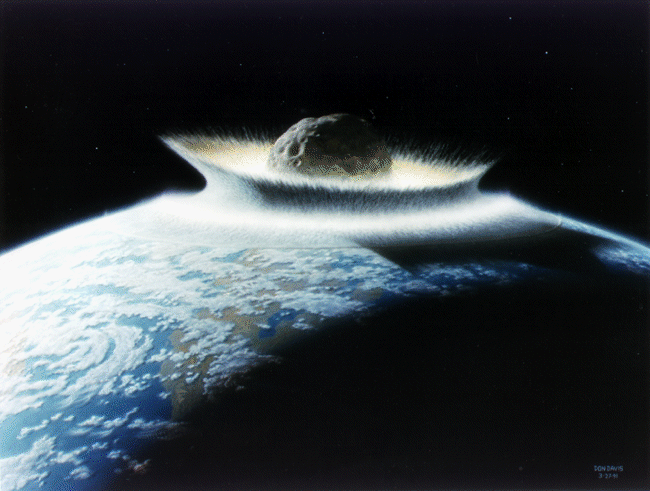
Impacts on Earth
Earth's atmosphere screens out small
objects,
but anything bigger than about a kilogram can make it to the
surface,
and
objects that are bigger than about a metric ton (1000 kg) can
create an
impact crater.
Here are some approximate times between impact events:
diameter of impactor in
meters
impact
interval in years
3
1
30
100
100
3000
1000
1
million ?
10000
100
million ?
The most famous impact crater is right here in Arizona. It was created by an iron meteorite about 50 m in diameter, about 50000 years ago (before there were humans in Arizona). The impact released about 20 megatons of TNT worth of energy (equivalent to a large thermonuclear warhead). In the floor of such impact craters, one finds breccia and shock-produced glass particles.
There are quite a number of older impact craters on Earth.
In 1980, the physicist Luis Alvarez and his geologist son, Walter Alvarez, shocked the scientific community by proposing a theory that the age of the dinosaurs was brought to an end 65 million years ago by a huge impact event.
The dinosaurs were one of the most spectacular and successful life forms that ever existed on Earth. These huge reptilian creatures dominated the Earth throughout the Mesozoic era (245 m.y.a. to 65 m.y.a.).
Nomenclature:
Mesozoic Era
Triassic
Period
Jurassic
Period
Cretaceous
Period
ABRUPT
TRANSITION HERE
Cenozoic Era (65 m.y.a. to present)
Tertiary
Period (65 m.y.a. to 1.6 m.y.a.)
Quaternary
Period (1.6. m.y.a. to present)
The genus homo (includes us and extinct close ancestors) has only been present in the Earth's environment since around the start of the Quaternary.
The transition from the Cretaceous period (K) to the Tertiary period (T) is sometimes called the K/T boundary. Geologically, it is very abrupt. The fossil record shows that not only did the dinosaurs disappear forever at this point, but vast numbers of other species, both marine and land-based, disappeared at the same time. Something very dramatic happened to the Earth.
The Alvarezes discovered that there is a thin (~ cm-thick) layer of clay between the T and K deposits, and that there is a large amount of iridium in this layer, worldwide. They calculated the size of an asteroid that could deposit that much extra iridium and found that it would have a diameter of about 10 km! Other excess siderophile elements have since been found in this layer, such as platinum, osmium, and gold.
Iridium (chondritic) / Iridium
(Earth's
crust) = 1430
Platinum (chondritic) / Platinum
(Earth's
crust) = 587
Gold (chondritic) / Gold (Earth's
crust)
=
104
An asteroid this size would have left a huge crater, bigger than 100 km in diameter. It wasn't found right away, which left the Alvarez theory in doubt.
How big would the explosion have been? Let's use the formula for kinetic energy:
1 km = 105 cm, so 1 cubic km = 1015 cm3. Radius of the asteroid = 5 km, so its volume = 4 pi r3/3 = 524 cubic kilometers = 524 x 1015 cm3.
Assume that the asteroid was a carbonaceous chondrite with a density of 3.5 gram/cm3, so its mass was 1.8 x 1018 g.
Now let's calculate the kinetic energy of the asteroid as it hits Earth. Remember that the formula for kinetic energy is
KE = (1/2) mv2
When the asteroid hits Earth, it is traveling at at least escape velocity for Earth, v = 11 km/s = 1.1 x 106 cm/s, so we get for the kinetic energy
KE = (1/2) 1.8 x 1018 x (1.1 x 106)2 = 1.1 x 1030 erg
This is equivalent to about two million big hydrogen bombs!
Here is what Earth looked like 65
million
years ago:

Artist's conceptions of the impact
and
resulting crater:

The impact site, many years later:

Two petroleum geophysicists finally found the crater in Mexico. The geophysicists were Glen Penfield (from Houston) and Antonio Camargo (Pemex). The crater site is near Chicxulub ("devil's tail" in Mayan) in the Yucatan. It is a huge (180 km diameter) multiring crater, buried under Tertiary sediments.
The aftermath of the impact: